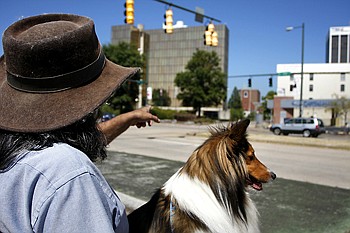Karl Epperson almost gets hit by a car at least twice a week.
The 64-year-old - who uses a service dog and motorized wheelchair to stay active - rides around downtown Chattanooga every day, sticking to sidewalks and always using crosswalks when he cuts across streets.
But it's still a potentially deadly game of chance.
"If you're not paying attention, you're going to get nailed," Epperson said.
In a city where cars, cyclists and runners all use the same pavement, another group of movers also shares the road - motorized wheelchair operators.
On any given day, wheelchair users can be found throughout downtown Chattanooga. Some are on sidewalks, some are on the road in the bike lanes that hug the shoulder, and some are cruising right in the middle of the traffic lane.
Roger Thompson, lead teacher for Haman's New Drivers driving school in Chattanooga, said he's been in several potentially dangerous situations when a student driver encounters a wheelchair operator.
"In downtown we see a number who take a calculated risk by riding a motorized wheelchair in the road," he said. "It's one of our greatest fears."
But wheelchair users say they must ride in the road at times. Sometimes there just isn't a sidewalk, they say, and even when there is, not all have curb ramps so they can get on and off at crosswalks. Other times, curb ramps are built at the corner of two sidewalks, not in the direct path of a crosswalk, meaning wheelchair users must travel into the lane to get onto a sidewalk.
"There are some places, like near Sixth Street and Chestnut, where part of your wheelchair has to be out in the lane of traffic just to get to the curb cut," Epperson said.
There's also a problem with drivers who don't stop behind white lines at red lights or look at the curbs when turning right on red.
"You're supposed to stop behind the white line and then ease forward if you're going to turn right," Epperson said. "People are usually looking to see what's coming from the left and not the pedestrians coming from the right."
Elaine Adams, therapeutic recreation coordinator for Chattanooga, works to provide leisure activities for people with all abilities. She said city projects to rebuild sidewalks could help by providing motorized wheelchairs a place to travel.
But in the meantime, wheelchair users will be in the road at times, she said.
"It's the same as if you jaywalked," Adams said. "There's not a lot of enforcement, but that doesn't make it OK."
Jim Pecht is with the U.S. Access Board, a federal agency in Washington, D.C., that writes guidelines for disability transportation. He said city renovations, particularly those with sidewalk reconstruction, must include wheelchair-accessible sidewalks and curb ramps.
Most wheelchair users would rather be on the sidewalks, he said, but if sidewalks and curb ramps aren't up to par, users have no choice but to ride in the streets.
DANGER ZONES* Sixth and Chestnut streets* Broad and Sixth streets* Seventh and Chestnut streets* Martin Luther King Boulevard and Carter Street* I-27 northbound at the Martin Luther King Boulevard exit* Public garages that exit onto streetsSource: Karl EppersonIT'S THE LAWChattanooga's only regulation for wheelchairs on streets is that it's unlawful to drive any vehicle that will "retard the orderly and safe use of the street," said Officer Rebecca Royval, spokeswoman for the Chattanooga Police Department.Under Tennessee law, an "electric person assistive mobility device" must yield to pedestrians and human-powered vehicles at all times. Motorized wheelchairs are not considered to be vehicles, motor vehicles, motor-driven cycles or all-terrain vehicles, according to the law.In Georgia, such devices may be operated only on highways and sidewalks with "a 48-inch clear path is maintained for access for persons with disabilities," according to a law passed in 2003. Wheelchair operators are expected to obey the same laws as pedestrians, the law states.
"If you use a wheelchair and you have to get to the bus to get to work and there's not a curb ramp or sidewalk on the way to the bus stop, then you have to use the streets," Pecht said. "You still have to make a living."
Who's at fault?
Determining exactly how many accidents and citations result from power chairs in the road is difficult from both a local and national perspective.
Locally, Chattanooga police citations don't break out wheelchair users from pedestrians in accident citations, which means researchers must go case-by-case to determine which involved wheelchairs.
National studies on the issue are scarce, but one released in July by the Department of Physical Medicine and Rehabilitation at the William Beaumont Hospital in Royal Oak, Mich., found that 56 percent of accidents between wheelchairs and vehicles resulted in fatalities.
The study looked at 107 newspaper articles detailing such accidents, with 60 fatalities. Ninety-four percent of the accidents involved a motorized wheelchair, the study said.
The wheelchair user was at fault in 39 percent of the cases, the study found, while the driver was at fault in 27 percent. The remaining cases were either unwitnessed hit-and-runs or no fault was found, the study said.
The study also said outside factors, including the mental state of the power-chair operator, must be considered as explanations for those who choose to use their motorized wheelchairs in public streets.
"Hubris or premeditated self-destructive behavior or both need to be explored as pre-eminent issues with reference to the [onset] of the 'accident process,'" according to the study.
Whether to call law enforcement on wheelchair drivers who might be endangering themselves is a "situation-by-situation decision," Pecht said.
"Would you call the cops on a teenager who was driving a bike down the street? Probably not," Pecht said. "Would you call the cops on someone walking drunk down the street? Probably."
Contact Jessie Gable at jgable@timesfreepress.com or 423-757-6345.
